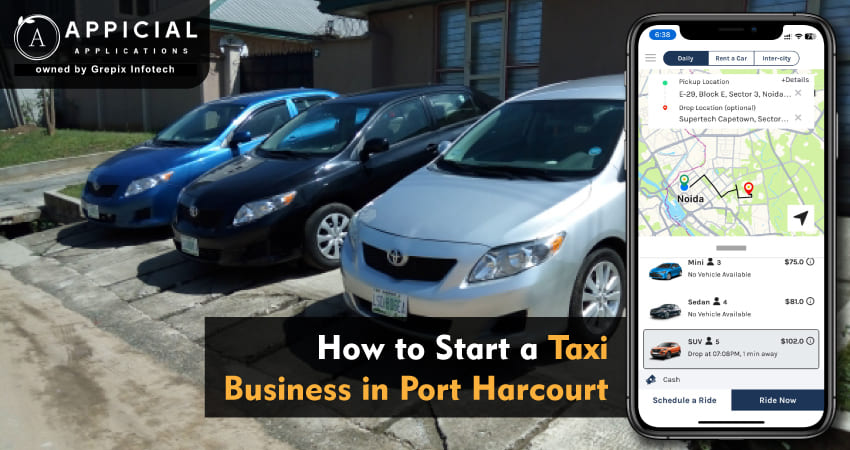
How to Start a Taxi Business in Port Harcourt: A Comprehensive Guide
The bustling city of Port Harcourt, known as the Garden City of Nigeria, offers a thriving environment for the taxi business. With a growing population and increasing urbanization, the demand for reliable transportation continues to rise. Starting a taxi business here can be both lucrative and rewarding if approached correctly.
In this guide, we’ll walk you through every step you need to take to establish a successful taxi business in Port Harcourt, from understanding the market to scaling your operations.
Port Harcourt’s bustling economy and growing population make it a prime location for starting a taxi business. This guide by Appicial Applications outlines key steps, including market research, fleet acquisition, licensing, and marketing. By leveraging technology and focusing on customer needs, entrepreneurs can create a successful and sustainable taxi business in Port Harcourt. With the right strategies and tools, your business can cater to the city’s demand for safe, efficient, and reliable transportation.Known as the “Garden City,” Port Harcourt is one of Nigeria’s most vibrant cities. Starting a taxi business here is an opportunity to serve its growing transportation needs while building a profitable venture.
How to Start a Taxi Business in Port Harcourt: Step By Step Guide
The bustling city of Port Harcourt, known as the Garden City of Nigeria, offers a thriving environment for the taxi business. With a growing population and increasing urbanization, the demand for reliable transportation continues to rise. Starting a taxi business here can be both lucrative and rewarding if approached correctly.
In this guide, we’ll walk you through every step you need to take to establish a successful taxi business in Port Harcourt, from understanding the market to scaling your operations.
1Understanding the Market
Researching the Demand
Before diving in, conduct thorough research on the local demand for taxis. Port Harcourt, being an economic hub, sees significant commuter activity, especially during peak business hours. Evaluate areas with high traffic, such as major roads, business districts, and residential areas.
Analyzing Competitors and Pricing Strategies
Assess existing taxi services in the city. What are their strengths and weaknesses? Identify gaps in their service and pricing. For instance, if most taxis lack proper maintenance or timely service, focus on offering reliable and punctual rides. Pricing competitively while ensuring profitability is crucial.
2Business Planning
Writing a Comprehensive Business Plan
A solid business plan is your roadmap. Outline your goals, target market, pricing, and expected revenue. Include an operational strategy, detailing how you’ll acquire vehicles, hire drivers, and manage day-to-day activities.
Determining the Type of Taxi Service
Consider whether you’ll run a traditional taxi business, a ride-hailing service, or a specialized option like luxury rides or shuttles. Each type has its own audience, requirements, and earning potential.
Legal Requirements and Licensing
- Registering Your Business: To operate legally, register your business with the Corporate Affairs Commission (CAC). Choose a business name that’s unique yet reflects your services.
- Obtaining Necessary Permits: Apply for permits from the Rivers State government. You’ll need a taxi operator’s license and vehicle registration specific to commercial use. Confirm requirements with local authorities to avoid fines.
- Insurance Requirements: Ensure all your vehicles are insured under a commercial vehicle policy. This protects both your drivers and passengers in case of accidents.
3Fleet Acquisition
Choosing the Right Vehicles
The type of vehicle you choose depends on your target market. Budget-conscious riders may prefer compact, fuel-efficient cars, while corporate clients might require sedans or SUVs.
Leasing vs. Purchasing Vehicles
Decide whether to lease or buy your fleet. Leasing reduces initial costs but may be more expensive in the long run. Purchasing gives you ownership but requires significant upfront investment.
Maintenance Considerations
A reliable fleet is key to customer satisfaction. Establish a maintenance schedule to keep vehicles in top condition. Invest in spare parts and build relationships with trusted mechanics.
4Financing Your Taxi Business
Exploring Funding Options
Starting a taxi business requires significant capital. Explore options such as bank loans, grants, or attracting investors. Some startups use a mix of personal savings and crowdfunding to minimize debt.
Calculating Costs
Break down costs into two categories: startup and operational. Startup costs include vehicle acquisition, licensing, and branding, while operational costs cover fuel, maintenance, and salaries.
5Setting Up Your Operations
Hiring Drivers and Setting Employment Terms
Your drivers represent your brand, so hiring the right team is essential. Look for individuals with valid driver’s licenses, clean driving records, and experience. Conduct interviews to assess their customer service skills and knowledge of Port Harcourt’s road network.
Installing Taxi Meters and GPS Systems
Install taxi meters to ensure transparent billing. GPS systems are equally vital, helping drivers navigate efficiently while enabling you to track their movements. Many customers prefer services that provide accurate, meter-based pricing over flat rates.
Setting Up an Office and Dispatch System
If you're starting with a fleet, establish a central office for operations. A good dispatch system is key to coordinating rides, especially during peak hours. Modern dispatch systems can integrate with ride-hailing apps to streamline bookings and ensure prompt service.
6Technology Integration
Using Ride-Hailing Apps
The taxi industry in Port Harcourt is rapidly shifting toward app-based services. Consider partnering with established platforms like Bolt or Uber, which are already popular in the city. These platforms connect you with a large customer base, making it easier to secure bookings.
Developing Your Own App
If you prefer to operate independently, invest in creating your own app. This requires a significant upfront investment but gives you full control over your operations. Ensure your app includes user-friendly features such as live tracking, digital payments, and ride history.
7Marketing Strategies
Branding Your Taxi Business
Strong branding helps you stand out in a competitive market. Choose a memorable business name, design an appealing logo, and ensure your vehicles are well-branded with consistent colors and signage.
Advertising Through Various Channels
Leverage multiple advertising channels to reach potential customers. Use social media platforms like Facebook and Instagram to showcase your services. Distribute flyers in busy areas like shopping malls and business districts. Consider radio ads for broader local reach.
Offering Promotions and Loyalty Programs
Attract new customers by offering first-ride discounts or referral bonuses. Establish loyalty programs where frequent riders earn points they can redeem for free or discounted rides. Customer retention is just as important as attracting new users.
Also Read: Driving to Wealth: How to Become a Billionaire in South Africa's Taxi Business
8Customer Service Excellence
Training Drivers in Customer Service Skills
Customer satisfaction is vital for success. Train your drivers to be polite, punctual, and helpful. Encourage them to maintain clean vehicles, avoid arguments, and provide assistance when necessary.
Addressing Passenger Complaints
No matter how well you prepare, complaints may arise. Establish a clear system for handling them promptly. Responding to feedback professionally and implementing changes based on constructive criticism will improve your reputation.
9Safety Measures
Ensuring Vehicle Safety
Conduct regular inspections to keep your vehicles in excellent condition. Faulty brakes, worn tires, or broken headlights not only endanger passengers but also damage your credibility.
Implementing Safety Features
Install essential safety features like onboard cameras, panic buttons, and emergency GPS alerts. These measures reassure passengers that their safety is a top priority and build trust in your brand.
10Environmental Considerations
Using Fuel-Efficient or Electric Vehicles
Modern customers are increasingly eco-conscious. Investing in fuel-efficient cars or electric vehicles can lower operational costs and appeal to environmentally aware riders.
Complying with Environmental Regulations
Port Harcourt has regulations aimed at reducing vehicle emissions. Ensure your fleet complies with these standards to avoid fines and demonstrate corporate responsibility.
11Managing Finances
Tracking Revenue and Expenses
Keep meticulous records of your income and expenditures. Use accounting software or hire a professional accountant to manage your finances effectively. Proper tracking helps identify profitable routes and minimize unnecessary costs.
Setting Competitive Yet Profitable Pricing
Pricing is a delicate balance. Overpricing may drive customers away, while underpricing can hurt your bottom line. Regularly review your pricing strategy to ensure it reflects operational costs while staying competitive.
12Scaling Your Business
Expanding Your Fleet
As your business grows, consider adding more vehicles to your fleet. Start with a manageable number and gradually increase based on demand. Expansion requires careful planning to maintain quality service.
Adding More Services
Diversify your offerings to cater to broader needs. For example, add airport transfer services, corporate contracts, or parcel delivery options. Diversification can boost your revenue streams significantly.
13Challenges and Solutions
Common Challenges
- High competition from established taxi services and ride-hailing platforms.
- Fluctuating fuel prices increasing operational costs.
- Managing customer complaints and driver behavior.
Effective Solutions
- Differentiate your services by focusing on reliability and quality.
- Optimize routes and invest in fuel-efficient vehicles to reduce costs.
- Offer regular training to drivers to improve customer satisfaction.
Conclusion
Starting a taxi business in Port Harcourt is a promising venture with the potential to serve the city’s bustling transportation needs. As a growing metropolis with a thriving economy, Port Harcourt offers a dynamic market for entrepreneurs ready to establish reliable and efficient taxi services.
At Appicial Applications, we specialize in taxi app development providing tailored solutions to help businesses succeed in the competitive transportation sector. From developing custom ride-hailing apps to offering fleet management tools, we provide everything you need to streamline your operations and deliver exceptional service to your customers.
Success in Port Harcourt’s taxi market requires more than just vehicles and drivers—it demands innovation, customer focus, and a commitment to quality. By partnering with Appicial Applications, you can create a brand that residents and visitors trust for their transportation needs. Are you ready to make your mark in Port Harcourt’s thriving transportation industry? Let us help you turn your vision into reality.
Looking out to start your own venture like Uber ? Try out our HireMe Taxi Uber Clone, the easiest way to kick-start your taxi business.
Author's Bio

Vinay Jain is the Founder at Grepix Infotech and brings over 12 years of entrepreneurial experience. His focus revolves around software & business development and customer satisfaction.
Back to blog list






